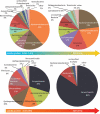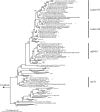New abundant microbial groups in aquatic hypersaline environments
- PMID: 22355652
- PMCID: PMC3216616
- DOI: 10.1038/srep00135
New abundant microbial groups in aquatic hypersaline environments
Abstract
We describe the microbiota of two hypersaline saltern ponds, one of intermediate salinity (19%) and a NaCl saturated crystallizer pond (37%) using pyrosequencing. The analyses of these metagenomes (nearly 784 Mb) reaffirmed the vast dominance of Haloquadratum walsbyi but also revealed novel, abundant and previously unsuspected microbial groups. We describe for the first time, a group of low GC Actinobacteria, related to freshwater Actinobacteria, abundant in low and intermediate salinities. Metagenomic assembly revealed three new abundant microbes: a low-GC euryarchaeon with the lowest GC content described for any euryarchaeon, a high-GC euryarchaeon and a gammaproteobacterium related to Alkalilimnicola and Nitrococcus. Multiple displacement amplification and sequencing of the genome from a single archaeal cell of the new low GC euryarchaeon suggest a photoheterotrophic and polysaccharide-degrading lifestyle and its relatedness to the recently described lineage of Nanohaloarchaea. These discoveries reveal the combined power of an unbiased metagenomic and single cell genomic approach.
Figures






References
-
- Rodriguez-Brito B. et al.. Viral and microbial community dynamics in four aquatic environments. ISME J 4, 739–751 (2010). - PubMed
-
- Gasol J. M. et al.. Control of heterotrophic prokaryotic abundance and growth rate in hypersaline planktonic environments. Aquatic Microbial Ecology 34, 193–206 (2004).
-
- Anton J., Llobet-Brossa E., Rodriguez-Valera F. & Amann R. Fluorescence in situ hybridization analysis of the prokaryotic community inhabiting crystallizer ponds. Environ Microbiol 1, 517–523 (1999). - PubMed
-
- Benlloch S. et al.. Archaeal Biodiversity in Crystallizer Ponds from a Solar Saltern: Culture versus PCR. Microb Ecol 41, 12–19 (2001). - PubMed
Publication types
MeSH terms
Substances
LinkOut - more resources
Full Text Sources
Other Literature Sources
Molecular Biology Databases
Miscellaneous

